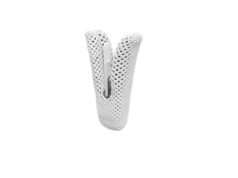
The use of TriClip (Abbott) for edge-to-edge repair in tricuspid regurgitation (TR) remains safe and effective at one year, preliminary outcomes from the TRILUMINATE study, presented at a late-breaking session at PCR London Valves 2019 (17–19 November, London, UK), indicate. Outlining the data, Georg Nickenig (University of Bonn, Bonn, Germany) said that among 87% of the patients with symptomatic or greater tricuspid regurgitation, the study demonstrated TR reduction of at least one grade. It also found a low rate of major adverse events, with no new device related adverse events after 30 days, and significant improvements in quality of life measures.
“I think we can show—admittedly in a small patient cohort—durable repair,” said Nickenig, adding: “This is a very safe procedure. We witnessed some clinical improvement and we saw also some positive reverse remodelling and improved RV function.”
Nickenig told Cardiovascular News that the one-year outcomes should “certainly help” towards achieving CE mark for the device, which is still pending.
TRILUMINATE is a prospective, multicentre, single-arm study in 21 sites in Europe and the USA; 30-day findings were announced earlier this year at EuroPCR 2019 (20–24 May, Paris, France), demonstrating safety and effectiveness, and a low complication rate.
Eligible patients were those with moderate or greater TR, with New York Heart Association (NYHA) class II or higher. Patients with systolic pulmonary artery pressure >60mmHg, a previous tricuspid valve procedure, or a cardiovascular implantable electronic device that would inhibit TriClip placement, were not suitable for enrolment.
Nickenig described participants as a “very sick patient group”, and explained: “Minimal invasive catheter based procedures may offer some promise to treat and tackle patients with tricuspid regurgitation. There have been some post-hoc registry data made available during the past years showing that MitraClip could be used to reduce tricuspid regurgitation in a certain patient cohort and this could be related to also to an improved clinical outcome or at least to an improved clinical performance.”
Participants were treated with the TriClip tricuspid valve repair system, a clip-based edge-to-edge repair technique. TR was graded as mild, moderate, severe, massive, and torrential. The primary efficacy endpoint was a reduction in severity of TR ≥one grade 30-days post-procedure, with a performance goal of 35%. The primary safety endpoint was a composite of major adverse events at six months, with a performance goal of 39%. Patients who did not reach six-month follow-up and did not have a major adverse event during previous follow-ups were excluded from the primary safety analysis. The trial has completed enrolment and follow-up is ongoing.
Nickenig reported one-year outcomes in the first 50 of 85 patients; this found a TR reduction of at least one grade among 87% of subjects with paired data. The proportion of subjects with moderate or less TR increased from 4% at baseline to 54% at 30 days, an improvement that was “sustained and improved” at one year, increasing to 64%, indicating, he said, “durable TR repair”.
In addition, the study demonstrated continued symptomatic improvement, he said, with increases in quality of life measures; the proportion of subjects in NYHA class I/II increased from 22% at baseline, to 84% at 30 days, and 80% at one year, and scores for the Kansas City Cardiomyopathy Questionnaire (KCCQ) and six-minute walk distances also improved between baseline and one year.
Nickenig added: “We saw some initial evidence for positive reverse remodelling on the right side of the heart.” The reduction of TR was associated with significantly decreased right ventricular dimensions suggesting positive remodelling, with significant improvements in right ventricular function.”
There were three major adverse events at one year (all cardiovascular mortality), with no myocardial infarction, stroke, or new onset renal failure. On additional safety endpoints, there were four deaths that were not related to the device or the procedure and one that was unlikely to be related. There were no new device related safety events beyond 30 days.
The findings have also been published in The Lancet.












